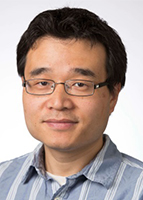报告时间:2019年6月28日(星期五)上午9:00
报告地点:能源楼(A座)一楼会议室
报告人:肖德泉副教授,纽黑文大学

报告摘要:
Owing to the development in modern theoretical and computational chemistry (e.g., density functional theory), predicting molecular properties using accurate and efficient quantum chemistry methods becomes more and more practical. As a consequence, inverse molecular design approaches based on quantum chemistry have emerged as an attractive computational approach to take on the challenges in materials discovery.
First, through the collaboration with the Green Chemistry and Green Engineering Center at Yale University, we explored the theoretical limits of reaction conditions for the hydrogenation and hydrogenolysis of biomass model compounds, using quantum chemistry calculations based on density function theory. Our results showed that thermodynamically it is indeed possible to design green hydrogenation catalysts that can work at the mildest conditions for converting biomass molecules into value-added chemicals.1 The thermodynamic study also helped us to understand the selectivity of an existing Cu-doped hydrotalciate catalyst in experiments.2 Second, we developed a new inverse molecular design method based on tight-binding electronic structure theory to search for novel hydrogenation catalysts. In this presentation, I will introduce the history of inverse molecular design method developed in my laboratory, based on the tight-binding electronic structure theory and the scheme of linear-combination-of-atomic-potential (called TB-LCAP). Our approach of inverse molecular design aims at searching for optimum points on the hypersurfaces defining the property-structure relationships, and then mapping out the molecular structures at the optimum points, leading to enhanced efficiency and success rate for materials discovery. We have applied the TB-LCAP inverse design method to successfully design nonlinear optical materials and dye-sensitized solar cells. Our results indicate that the inverse molecular design approach could be a useful tool to search for promising green heterogeneous catalysts for converting lignocellulosic biomass into value-added chemicals such as liquid fuels.
报告人简介:
肖德泉在四川大学获得化学学士学位(1996)和高分子化学硕士学位(1999)。他在美国杜克大学获得化学博士学位(2009),然后在耶鲁大学进行了四年的博士后研究工作(2009-2013)。他自2013起在美国纽黑文大学任助理教授,从事教学和科研工作。2019年获得终身教职并晋升副教授。现在是纽黑文大学综合材料发明中心的主任,并获得“贝克曼主任教授”称号。他曾在2014-2019年担任美国宇航局康涅狄格州研究基金的顾问。肖德泉的研究兴趣是发展化学材料的理论设计和模拟方法,来推动新材料的设计与发明,是分子反向设计方法的先驱者之一。他在高影响力的杂志发表论文47篇,被引用达1182次。他实验室现在主要的研究方向是:生物质转化的绿色催化剂的设计,白血病的分子药物设计,以及高分子纳米复合材料设计的研究。
联系人:DNL0603 张晓辰
联系电话:89798

